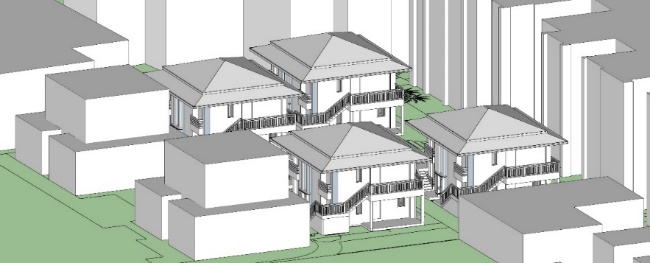Evaluation Criteria of Low Carbon Destination Concept for Resort Design and Renovation in Koh Chang, Thailand
Main Article Content
Abstract
Resort or hotel is a type of building widely affecting the global warming and increased level of Green House Gases (GHGs). The proficient selection of architectural components in resort design process has a significant impact on sustainability and energy efficiency of the involved buildings. This research studied the reviewed factors from the resort’s low carbon destination concept, which affect the architectural design of the resort. The reviews included the sustainable architectural design standards and environmental technology theories which are; the Standard of Green Leaf Hotels and, the Thai’s Rating of Energy and Environmental Sustainability (TREES). The concluded key factors were proposed as an improved set of indicators for extended evaluation criteria of resorts and hotel, to include the architectural design impact of the building. The architectural design evaluation and guideline proposal for resort design based on the concept of resort’s low carbon destination were initially tested on tree cases (A) The Dewa, Koh Chang Hotel; (B) The Spa Koh Chang Resort; and (C)The Koh Chang Kacha Resort and Spa. The result revealed that the resort with the most passable evaluation was (B) The Spa Koh Chang Resort followed by (A) The Dewa, Koh Chang Hotel and (C)The Koh Chang Kacha Resort and Spa, respectively. Hence, the researcher further used (C) for an in-depth case study to review the effect of architectural design components through simulation Three computer programs were employed in the simulation processes eQuest 3.64 for energy consumption PHOENICS VR for natural ventilation; and DIALux evo for daylight quality. The simulation results from the improved case(C) with consideration on the improvement of architectural components such as window design for ventilation, the use of low-emissivity glazing, high reflectance paint of wall and roof, the increase of roof projection, the used of window shadings and the landscape design around buildings, revealed the significantly improved evaluation outcomes. In conclusion, these improved components are keys to the success in achieving the sustainable resort’s architectural design indicators and can effectively utilize both daylight quality and natural ventilation to further lower the level of energy usage.
Downloads
Article Details

This work is licensed under a Creative Commons Attribution-NonCommercial-NoDerivatives 4.0 International License.
All material is licensed under the terms of the Creative Commons Attribution 4.0 International (CC-BY-NC-ND 4.0) License, unless otherwise stated. As such, authors are free to share, copy, and redistribute the material in any medium or format. The authors must give appropriate credit, provide a link to the license, and indicate if changes were made. The authors may do so in any reasonable manner, but not in any way that suggests the licensor endorses you or your use. The authors may not use the material for commercial purposes. If the authors remix, transform, or build upon the material, they may not distribute the modified material, unless permission is obtained from JARS. Final, accepted versions of the paper may be posted on third party repositories, provided appropriate acknowledgement to the original source is clearly noted.
References
Buunyatikarn, S. (1999). Energy-saving house design techniques For a better quality of life. Bangkok: Chulalongkorn University.
Department of Environmental Quality Promotion. (2012). Standard of Green accommodation establishment.Retrieved from http://thaigreenhotel.com/home/download3.php?linkPath=../upload/download/file/file436670165.pdf&downloadFile=file-436670165.pdf&dataid=8
Sintunawa, T. (2008). Green Leaf Foundation. Retrieved from http://infofile.pcd.go.th/ptech/GP_11Jun08_Greenleaf.pdf
Sintunawa, T. (2017). Vice President and Secretary of the Green Leaf Foundation and President of Association for the Development of Environmental Quality.
Sotharak, S., & Tochaiwat, K. (2013). Tree-Star Hotel Development Process Under The Asean Dreen Hotel Standard For Thai Entrepreneurs. Retrieved from https://www.researchgate.net/profile/DrKongkoon_Tochaiwat/publication/240587318_THREESTAR_HOTEL_DEVELOPMENT
Srisutapan, A. (2009). Environmental Technology in Tropical architectural design. Bangkok: Thammasat University
Thai Green Building Institute. (2012). Thai’s Rating of Energy and Environmental Sustainability for New Construction and Major Renovation. Bangkok: Chulalongkorn University
Thipchai, M., & Pokharatsiri, J. (2019). Toward Resort Design with Low Carbon Destination Concept in Koh Chang Designated Area for Sustainable Tourism. The 9th Built Environment Research Associates Conference 2018 (BERAC 9). Faculty of Architecture and Town Planning Thammasat University (Bangkok: GBP Center Company Limited), 57-69.
U.S. Green Building Council (USGBC). (2018). LEED v4 for Building Design and Construction. Retrieved from https://www.usgbc.org/resources/leed-v4-building-design-and-constructioncurrent-version
Victor, O. (1962). Design with Climate. New Jersey: Princeton Hall.
World Tourism Organization, Sustainable Development of Tourism (UNWTO). (2008). Retrieved from http://sdt.unwto.org/sites/all/files/docpdf/climate2008.pdf


